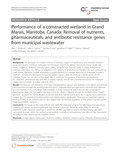| dc.contributor.author | Anderson, Julie C. | |
| dc.contributor.author | Carlson, Jules C. | |
| dc.contributor.author | Low, Jennifer E. | |
| dc.contributor.author | Challis, Jonathan K. | |
| dc.contributor.author | Wong, Charles S. | |
| dc.contributor.author | Knapp, Charles W. | |
| dc.contributor.author | Hanson, Mark L. | |
| dc.date.accessioned | 2017-11-03T20:54:24Z | |
| dc.date.available | 2017-11-03T20:54:24Z | |
| dc.date.issued | 2013 | |
| dc.identifier.citation | Anderson, Julie C., Jules C. Carlson, Jennifer E. Low, Jonathan K. Challis, Charles S. Wong, Charles W. Knapp, and Mark L. Hanson. "Performance of a constructed wetland in Grand Marais, Manitoba, Canada: Removal of nutrients, pharmaceuticals, and antibiotic resistance genes from municipal wastewater." Chemistry Central Journal 7 (2013), article no. 54. DOI: 10.1186/1752-153X-7-54 | en_US |
| dc.identifier.issn | 1752-153X | |
| dc.identifier.uri | http://hdl.handle.net/10680/1326 | |
| dc.description.abstract | BACKGROUND: The discharge of complex mixtures of nutrients, organic micropollutants, and antibiotic resistance genes from treated municipal wastewater into freshwater systems are global concerns for human health and aquatic organisms. Antibiotic resistance genes (ARGs) are genes that have the ability to impart resistance to antibiotics and reduce the efficacy of antibiotics in the systems in which they are found. In the rural community of Grand Marais, Manitoba, Canada, wastewater is treated passively in a sewage lagoon prior to passage through a treatment wetland and subsequent release into surface waters. Using this facility as a model system for the Canadian Prairies, the two aims of this study were to assess: (a) the presence of nutrients, micropollutants (i.e., pesticides, pharmaceuticals), and ARGs in lagoon outputs, and (b) their potential removal by the treatment wetland prior to release to surface waters in 2012.
RESULTS: As expected, concentrations of nitrogen and phosphorus species were greatest in the lagoon and declined with movement through the wetland treatment system. Pharmaceutical and agricultural chemicals were detected at concentrations in the ng/L range. Concentrations of these compounds spiked downstream of the lagoon following discharge and attenuation was observed as the effluent migrated through the wetland system. Hazard quotients calculated for micropollutants of interest indicated minimal toxicological risk to aquatic biota, and results suggest that the wetland attenuated atrazine and carbamazepine significantly. There was no significant targeted removal of ARGs in the wetland and our data suggest that the bacterial population in this system may have genes imparting antibiotic resistance.
CONCLUSIONS: The results of this study indicate that while the treatment wetland may effectively attenuate excess nutrients and remove some micropollutants and bacteria, it does not specifically target ARGs for removal. Additional studies would be beneficial to determine whether upgrades to extend retention time or alter plant community structure within the wetland would optimize removal of micropollutants and ARGs to fully characterize the utility of these systems on the Canadian Prairies. | en_US |
| dc.description.sponsorship | Funding was provided by the Riddell Endowment Fund, Manitoba Conservation and Water Stewardship, the Natural Sciences and Engineering Research Council of Canada, and the Canada Research Chairs Program. | en_US |
| dc.description.uri | https://ccj.biomedcentral.com/articles/10.1186/1752-153X-7-54 | |
| dc.language.iso | en | en_US |
| dc.publisher | Chemistry Central Ltd. | en_US |
| dc.rights | info:eu-repo/semantics/openAccess | |
| dc.subject | Sewage lagoon | en_US |
| dc.subject | Wastewater | en_US |
| dc.subject | Treatment wetland | en_US |
| dc.subject | Antibiotic resistance genes | en_US |
| dc.subject | Pesticides | en_US |
| dc.subject | Pharmaceuticals | en_US |
| dc.title | Performance of a constructed wetland in Grand Marais, Manitoba, Canada: Removal of nutrients, pharmaceuticals, and antibiotic resistance genes from municipal wastewater | en_US |
| dc.type | Article | en_US |
| dc.identifier.doi | 10.1186/1752-153X-7-54 | |

